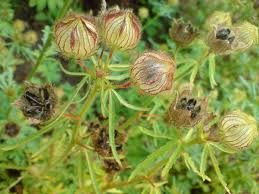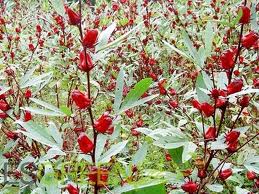Hibiscus
Pot Cultivation
Any ordinary garden soil will do as long as it isn't excessively dry. Tropical Hibiscus that are grown in greenhouses need a sunny location and a minimum winter temperature of 45-50 degrees. In the spring they should be pruned by shortening the side shoots by two-thirds and when they have started into new growth, a 55- to 65-degree temperature should be maintained. Large plants may be grown in large pots or tubs, or they may be planted in a bed in the greenhouse and either grown as bushes or trained to wires or a trellis on a wall. H. moschuetoes, the Rose Mallow or Swamp Hibiscus, can be grown in 5- to 20-gallon containers of wet soil or under up to 6 inches of water in a water garden. It should be located in sun or partial shade.Propagation
Tropical Hibiscus: Cuttings, 3 inches long, can be inserted into sand and peat moss in March and April in a propagating case in the hothouse. They are kept there until they form roots, they are then potted in 3-inch pots and, later, in larger pots. When they are 6 inches long, the main shoots and side branches are pinched to encourage bushy growth.
Hardy perennials: Seeds can be sown in drills 1 inch deep in light soil in May or June. The seedlings are transplanted, 6 inches apart, in a nursery bed and set in their final positions in the fall. They may also be divided.
Annual varieties: Seeds may be sown in rows that are 4-6 feet apart in fertile soil.
Okra: Sowing should be done when the weather is completely warm and settled. Seeds of H. esculentus should be planted a few inches apart and about an inch deep in rows spaced 4 to 5 feet apart. The plants should be thinned to stand 2 to 3 feet apart. These distances are meant for tall varieties; dwarf varieties, which bear less profusely, may be spaced closer. Frequent cultivation throughout the summer should be practiced. The pods are harvested while still young and tender. A long succession of picking is provided through the summer and until the coming of frost.
Hardy flowering varieties: Cuttings can be inserted into a sand bed in the summer and set in a cold frame or greenhouse which is kept closed until roots have formed. They are then planted in a nursery bed and finally they are moved to their permanent spot. Named varieties may also be grafted on the common kind in March. These plants can also be propagated by hardwood cuttings taken in the fall.
 |
 |
H. cannabinus |
H. Sabdariffa |
VARIETIES
- Tropical kinds:
H. Rosasinensis (Rose of China);
H. cannabinus;
H. Eetveldeanus;
H. mutabilis (Cotton Rose, Confederate Rose);
H. schizopetalus;
H. tiliaceus. Hardy Perennials:
H. Moscheutos (Rose Mallow or Swamp Hibiscus);
H. grandiflorus;
H. oculiroseus. - Some of the best hybrids are:
Clown (white & pink w/ crimson center), Crimson Wonder (crimson-red); Fresno (silvery pink); Satan (velvety crimson); Snow White (pure white); Poinsettia (red); Silver Rose (pink); White Giant (white). - Annual Kinds:
H. Tritonum (Flower of an Hour);
H. esculenta (Okra);
H. Sabdariffa (Roselle or Jamaica Sorrel);
H. Manihot. Hardy flowering shrub:
H. syriacus (Rose of Sharon or Shrub Althaea). Single-flowered kinds are: coelestis, Hamabo, Mauve Queen, totus albus, Woodbridge, and ruber. Double-flowered kinds are: ardens, Jeanne d'Arc, coeruleus plenus, Leopoldii plenus and paeoniflorus.




